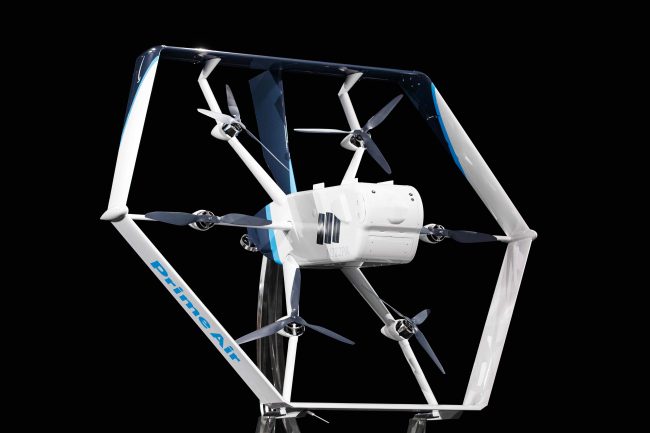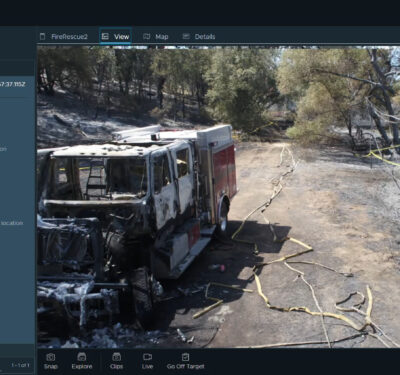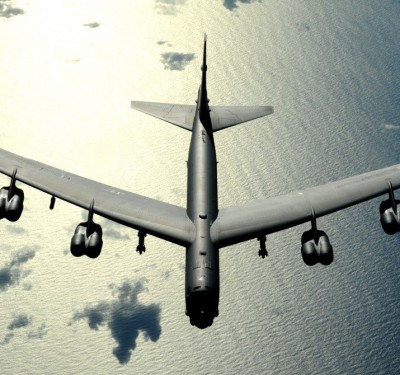
Photos courtesy of Amazon Prime Air.
Amazon Prime Air has filed a request for waivers to enable it to test its latest unmanned aircraft (UA) in the United States.
“We’ve been hard at work building fully electric drones that can fly up to 15 miles and deliver packages under five pounds to customers in less than 30 minutes,” wrote Jeff Wilke, CEO of Amazon’s Worldwide Consumer, in a June 5 blog post on aboutamazon.com. “And, with the help of our world-class fulfillment and delivery network, we expect to scale Prime Air both quickly and efficiently, delivering packages via drone to customers within months.”
Amazon is working toward a highly autonomous system, it said in its waiver application to the Federal Aviation Administration (FAA), and will base its initial operations on the MK27—a drone chosen from approximately 50,000 candidate configurations. The UA will have a maximum takeoff weight of 88 pounds including the aforementioned payload of up to 5 pounds, the company said. The round-trip range will be 15 nautical miles
The drone has undergone extensive testing from hardware/software simulation and accelerated life-testing of hardware components to validation of its concept of operation (ConOps) and development of an incident response program. The Prime Air drone also already incorporates two key capabilities for practical long-distance flights: remote ID of the aircraft and its operator and onboard collision avoidance.
In anticipation of the need for onboard detect-and-avoid capability Prime Air said it “made the early program decision to prioritize creating the technological means by which our UA can remain independently safe and demonstrate the equivalent means of performing the SAA (sense and avoid) functions that would otherwise be the responsibility of an onboard pilot.”
The MK27 includes an onboard solution that uses custom-built sensors and algorithms that have been tested and qualified against real world, synthetic and simulated datasets, at scale, the firm said. These algorithms yield outputs that are mapped to a safe action for accident avoidance.
Prime Air’s remote identification capability is able to identify what individual or entity is operating a drone in a given area; determine if the operation of that UA is authorized and facilitate the sharing of safety critical information.
“This system will be incorporated into our flight operations, in compliance with standards being developed through ASTM International, an industry standards development organization,” the company said. “Prime Air will also be prepared to comply with all requirements that may be defined through future FAA rules.”
Amazon Air has also been testing its remote ID capability as part of an overall unmanned traffic management system in cooperation with NASA and the FAA in the U.S. and the European Council’s Single European Sky ATM Research (SESAR) Joint Undertaking’s (U-Space) Demonstrator project in the European Union.
“We have long advocated for the formal regulatory adoption of such a remote ID system to facilitate the integration of UAS into the airspace more broadly,” the firm wrote, “Prime Air’s UTM system—which offers these safeguards—is ready to be deployed in support of our initial commercial delivery operations.”

Amazon Prime Air has filed a request for waivers to enable it to test its latest unmanned aircraft in the U.S. Photo: JORDAN STEAD / Amazon
The public’s view of the request has, so far, been overwhelmingly negative. Of the roughly two dozen who filed comment as of August 15 most were concerned about the safety of the MK27 including whether it could malfunction, be crashed by a bird strike, interfere with manned aircraft or be commandeered by someone up to no good. Several pointed out that once Amazon was granted a waiver other firms would more likely be granted waivers too, compounding any problems in the increasingly crowded skies including those of the hobbyist pilots who are already facing restrictions.
A number of other commenters, including Richard Hohm were worried about noise “of an especially irritating type.” Holm said he could “easily picture the frequent overhead buzz-whine becoming a nuisance everywhere and making life near an Amazon warehouse intolerable.”
Holm also worried about the privacy of those on the ground being undermined by sensor-equipped delivery drones hoovering up information as they pass overhead.
“I also think it reasonable to assume that Amazon’s drones will incorporate a variety of video and other sensors whose output will be sent to Amazon, possibly in real time,” Hohm wrote. These drones will be passing low over residences, past office buildings, and near other private spaces. The potential for violation of privacy and other abuses on an Orwellian scale is obvious, and could well be realized. As with other giant tech companies, Amazon has an insatiable thirst for data of all types. It is very, very safe to assume that Amazon will capture and store every bit of data returned from its drones, and that this data will be used in ways the people being observed neither desire nor consent to, both by Amazon and other companies and government agencies with which the company might share or sell that information.”
He suggested that the FAA, Department of Transportation and other agencies require Amazon to adopt and adhere to a strict set of standards forbidding it from storing, selling or otherwise sharing any data collected from its drones.
Comments, which should be filed under docket FAA-2019-0573 at regulations.gov, are due by August 28.






